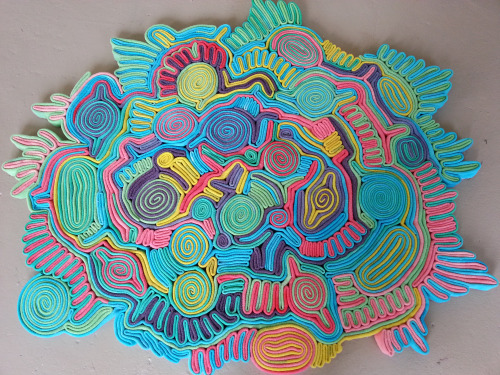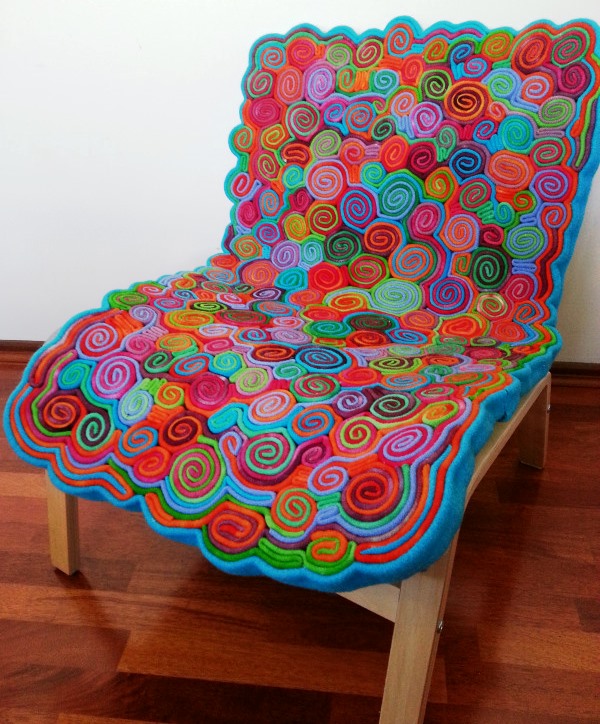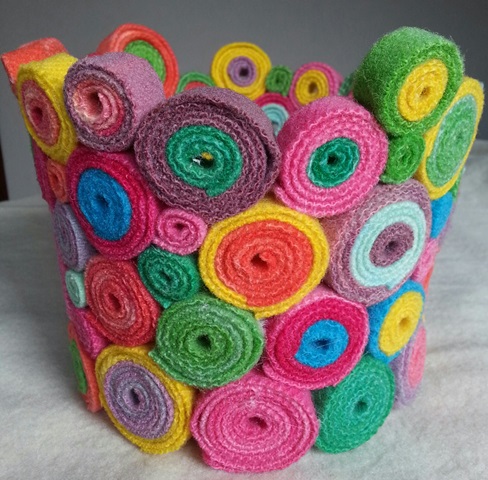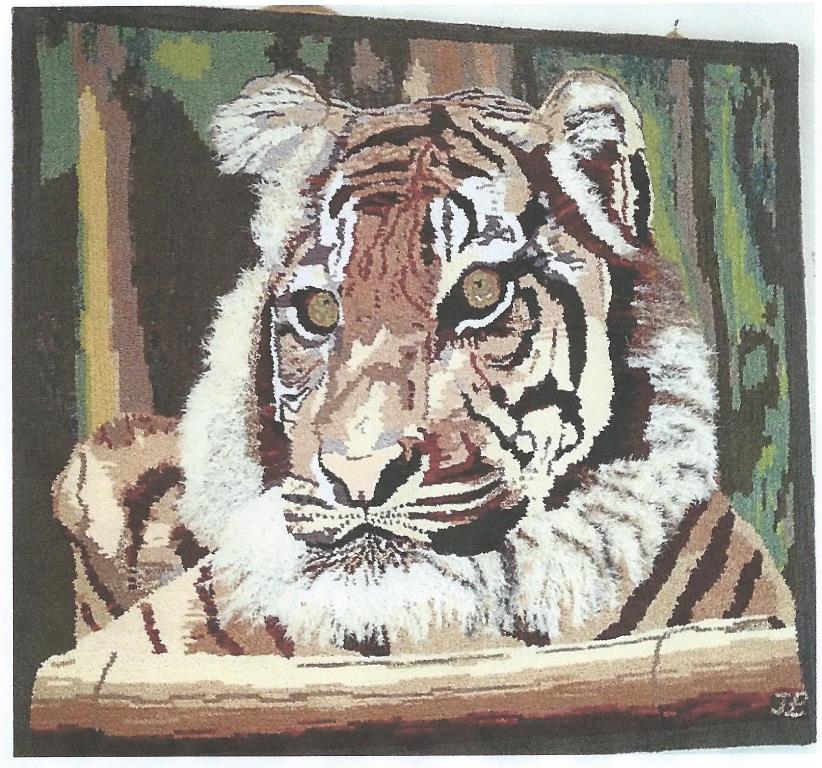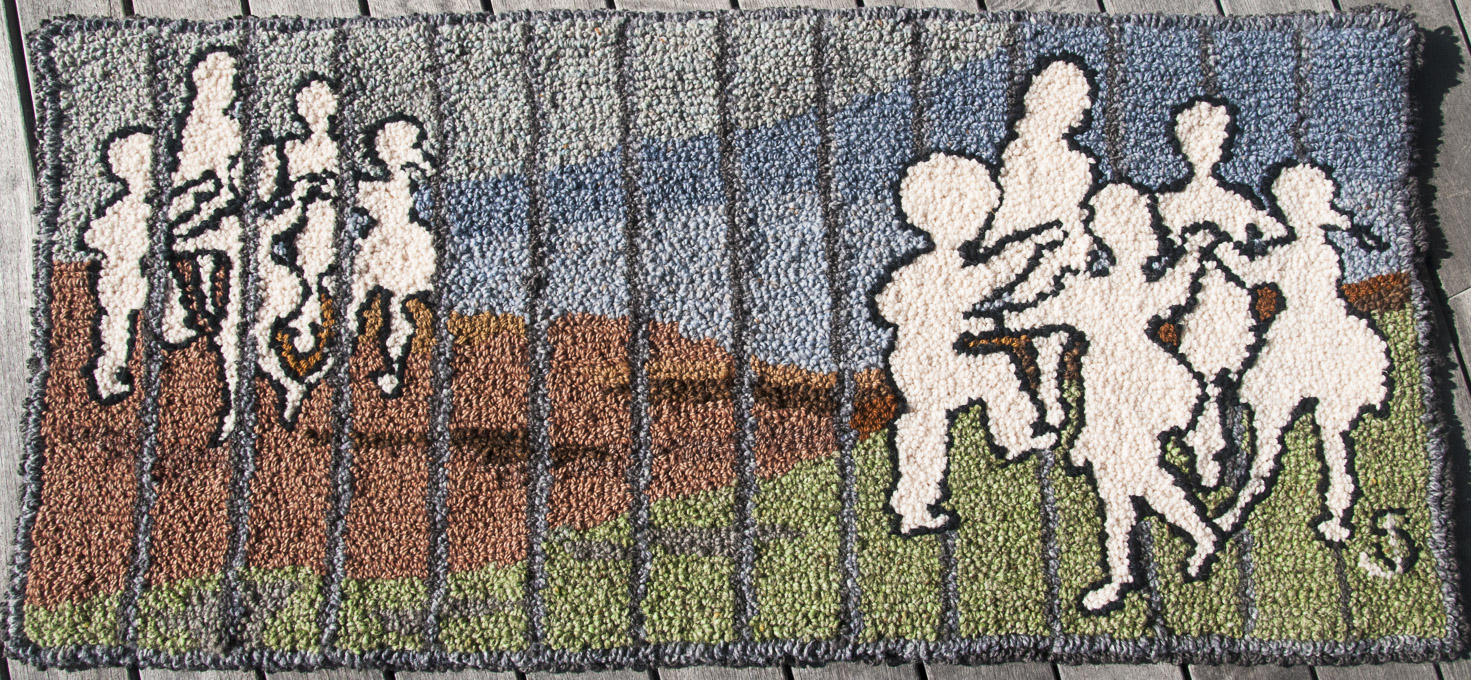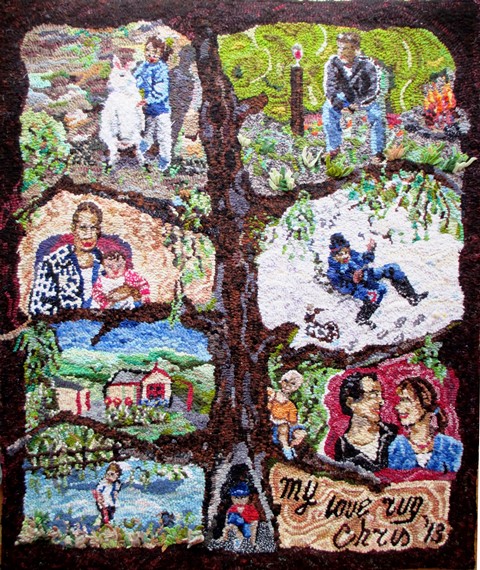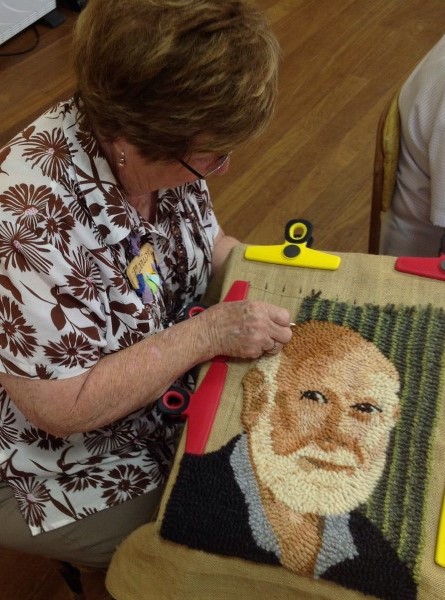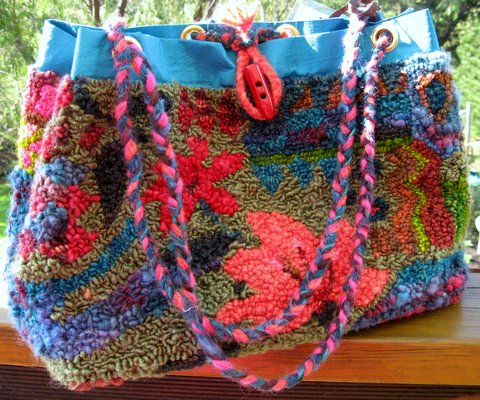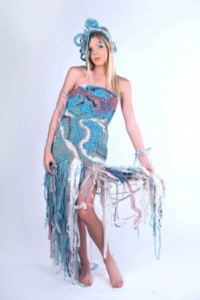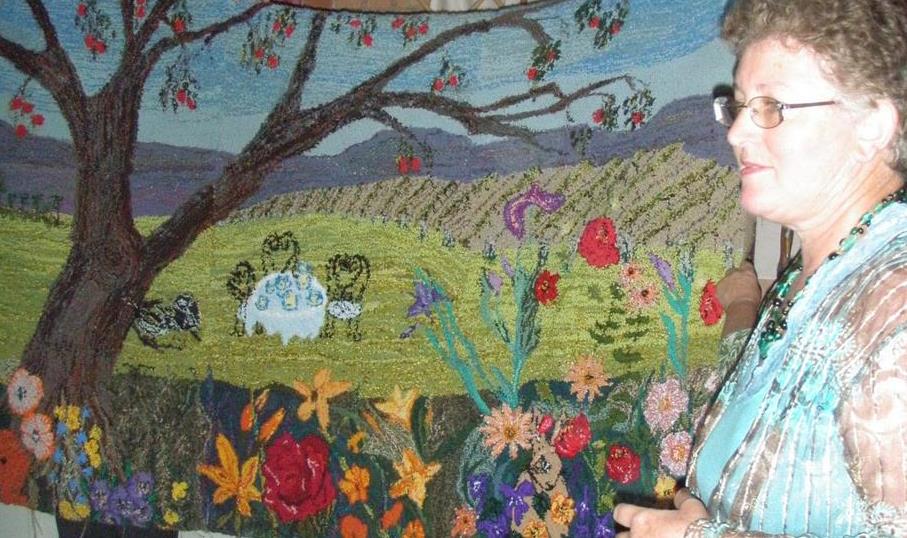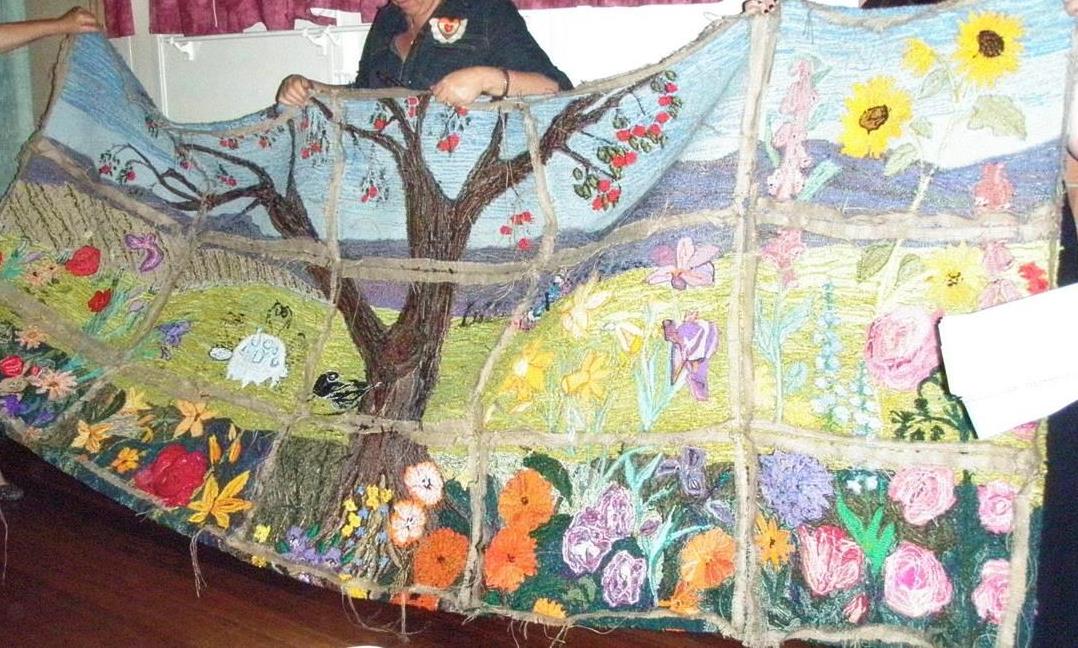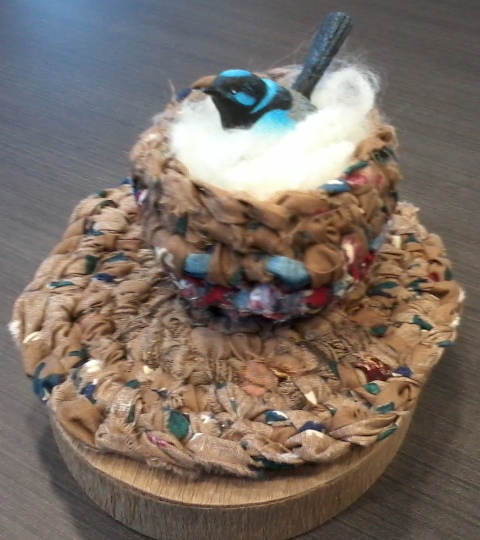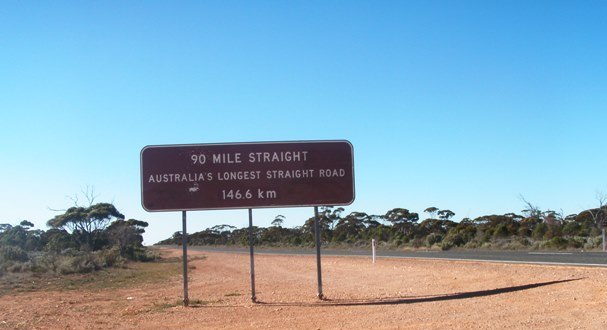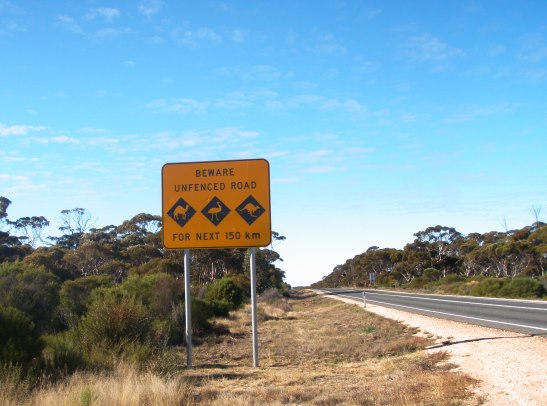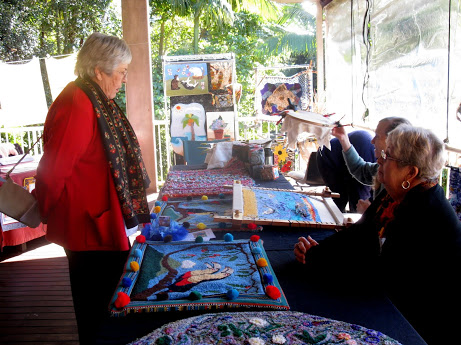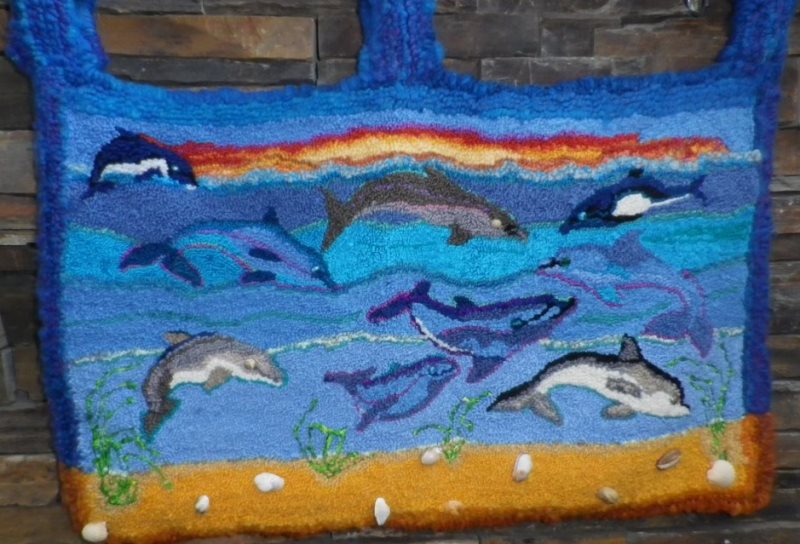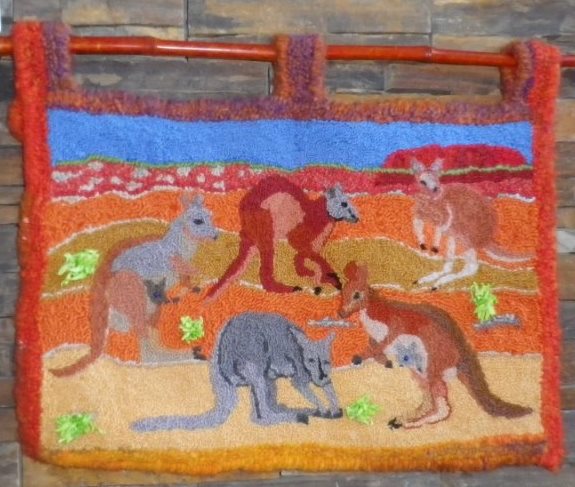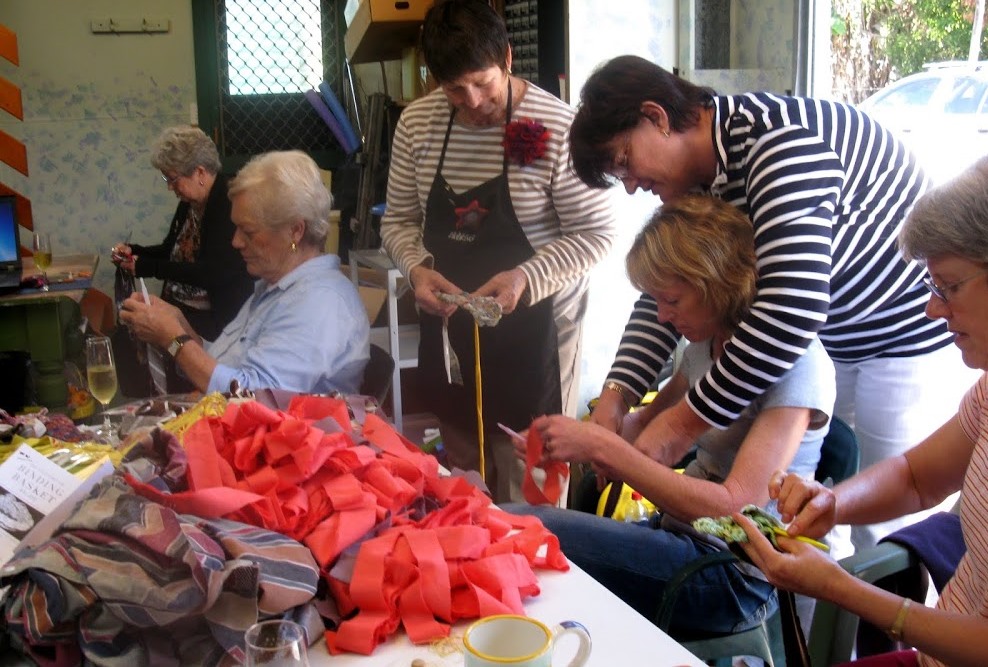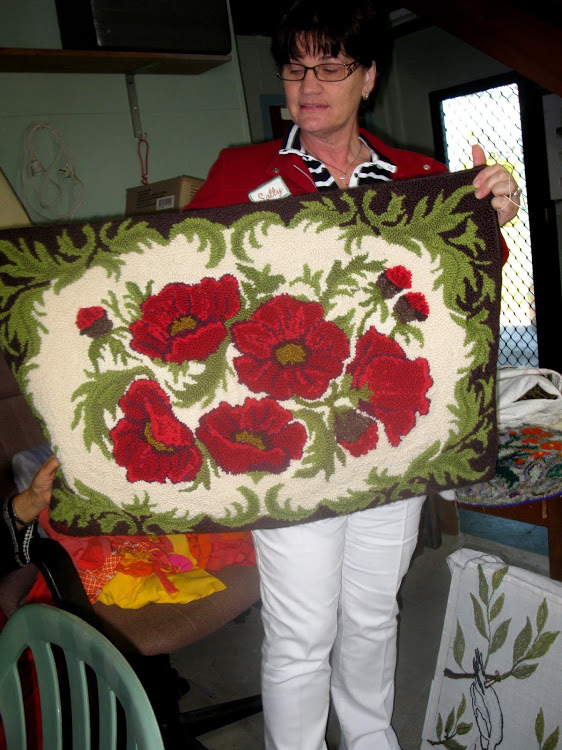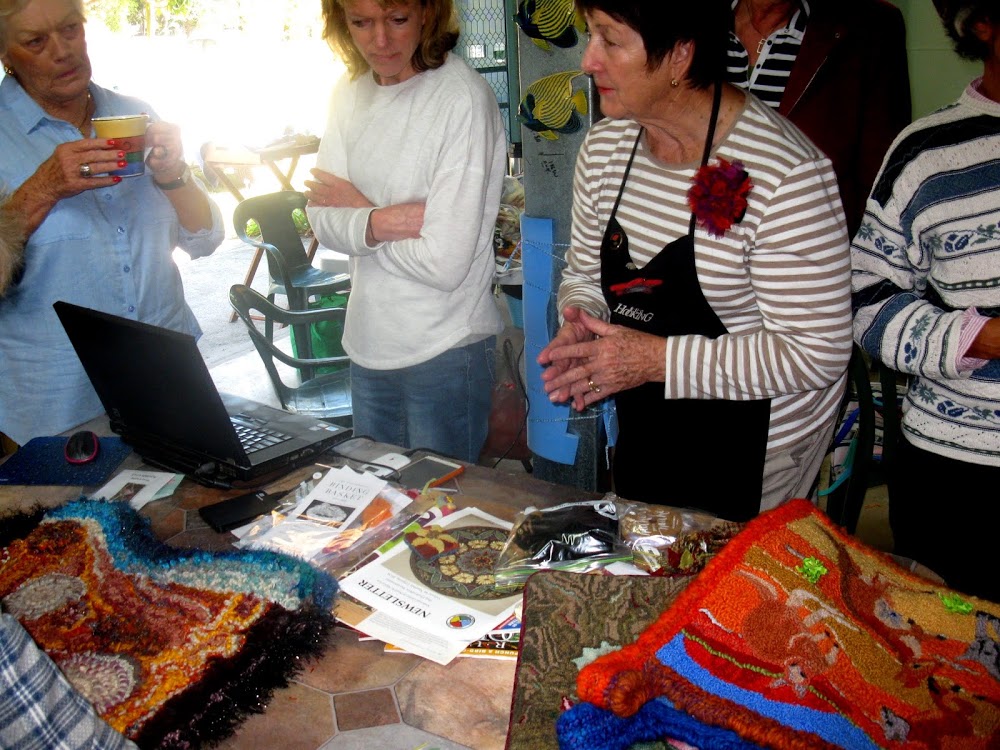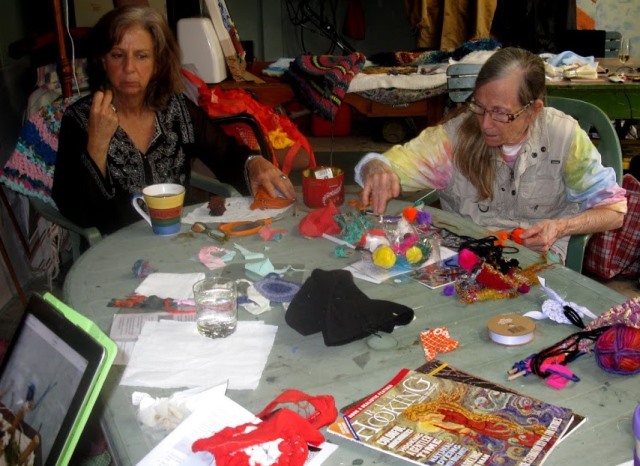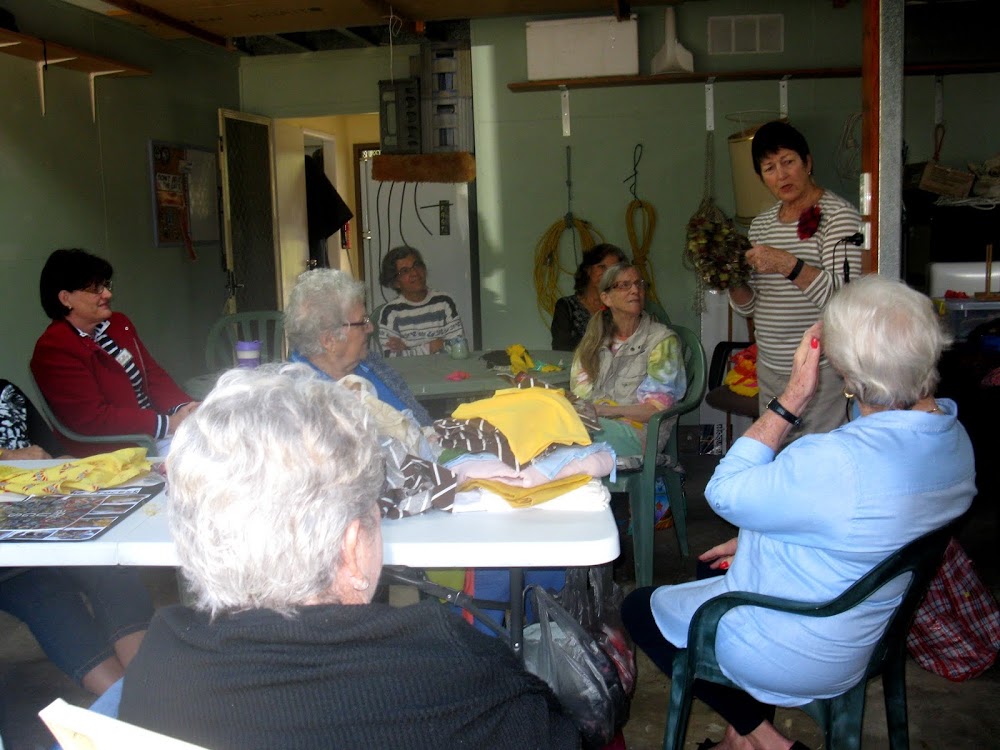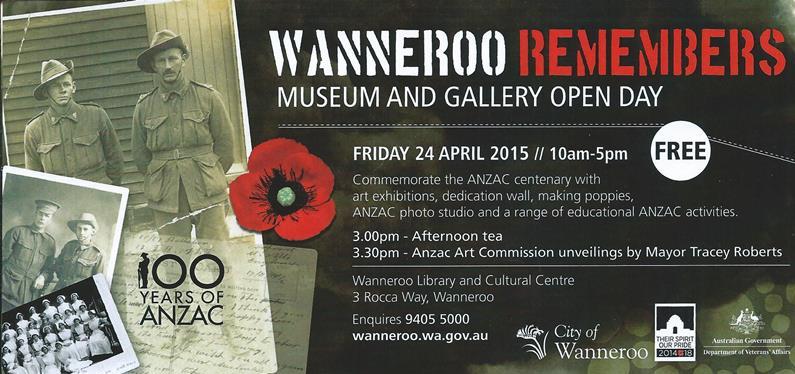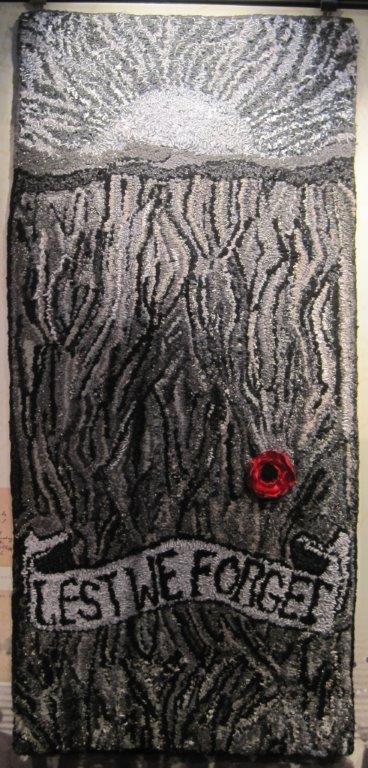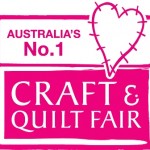ISSN 2007-00IX 30 November 2019
 How do you bring a small number of enthusiastic rug hookers scattered across vast distances together? With great difficulty!
How do you bring a small number of enthusiastic rug hookers scattered across vast distances together? With great difficulty!
… that is until the internet became more accessible by those with iPads and  mobile phones, allowing them to research, learn and view works by others – think Blogs and YouTube.
mobile phones, allowing them to research, learn and view works by others – think Blogs and YouTube.
While Social Media has it’s problems, it does allow for quick and easy exchanges of information and gives people a chance to come together to show their work and share their experiences with sourcing tools and finding ways of learning new techniques.
When the Australian rug making online groups were formed and the Guild Blog started they were seen by rug makers in the Northern Hemisphere who told friends and relatives in Australia about what was happening here and so contact was made within the country through an overseas connection – a boomerang effect.
Rug making is a tactile craft, more suited to being shown in an environment where the pile and texture can be appreciated. However if you can’t afford, or are unable to travel, online and virtual events open up a world of creativity.
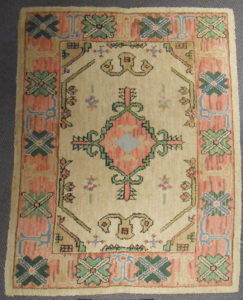
It’s often claimed that rug hooking was something “not done” in Australia and yet there are rugs in museum archives here dating back to the 1920s and 30s even to the late 1800’s like this rug in the Wool Centre, Ross, Tasmania.
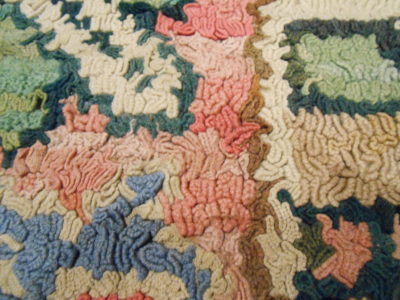
In those early days, rugs were used and disposed of, or stored and forgotten.
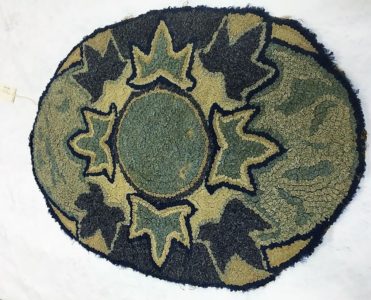
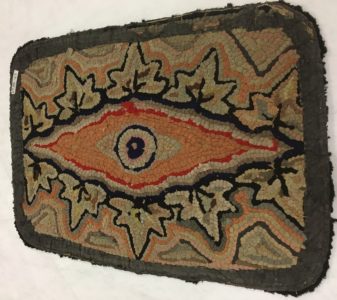
Small isolated communities had no way of promoting their events – exhibitions may have made the local newspapers but that was it.
In 2008, a rug hooking exhibition in the country town of Strathalbyn, South Australia, was advertised as the “first rug hooking exhibition in South Australia”. This proved to be incorrect; a rug hooker from Elizabeth, a 3 hour drive from Strathalbyn, saw a few lines of advertising in the Adelaide city newspaper on the morning of the opening and called to say it was definitely NOT the first exhibition in South Australia – there had been many. The problem was, the previous exhibitions had also been in country towns and reported in local newspapers – but the information did not leave the district.
 Joyce Emery one of the original members of the American Rug Hooking Group from Elizabeth, SA. said the group taught rug hooking in schools and country towns in regional South Australia. They held many exhibitions and for more than 30 years met once a month at the home of Pam Whitehead, their instructor who’d learned traditional rug hooking in Canada, bringing it to Australia in the late 1960’s. Pam taught the “traditional North American” style of rug hooking at Adult Education Classes held in the Elizabeth East High School, using hand-dyed wool swatches and the traditional ‘fine shading’ technique on designs (mostly florals) which she imported from Rittemere, a rug hooking supply store in Canada.
Joyce Emery one of the original members of the American Rug Hooking Group from Elizabeth, SA. said the group taught rug hooking in schools and country towns in regional South Australia. They held many exhibitions and for more than 30 years met once a month at the home of Pam Whitehead, their instructor who’d learned traditional rug hooking in Canada, bringing it to Australia in the late 1960’s. Pam taught the “traditional North American” style of rug hooking at Adult Education Classes held in the Elizabeth East High School, using hand-dyed wool swatches and the traditional ‘fine shading’ technique on designs (mostly florals) which she imported from Rittemere, a rug hooking supply store in Canada.
This is where the internet came into play; the information about Pam was seen online by Pam’s son Peter, who provided an update on his mother’s interesting life:-
Pam Whitehead was born near Doncaster, Lancashire, England, June 20, 1923.
She served in the WRAF in WW2 as a radio operator and after WW2 moved to Australia where she married Peter’s father (Lewis) in 1953, in Goondiwindi, Queensland.
In 1955 Pam moved to Canada staying in the UK for about a year on the way. Peter was born in the UK in 1954. Pam returned to Australia (Elizabeth, South Australia) in July 1969 and taught at various locations over time, the main ones being the Elizabeth Girls Technical High School and Nuriootpa High School. Pam passed away in 2006. Peter said – “my mother was involved in many crafts but Rug Hooking was her passion. She would have been so happy to see it continue to flourish in Australia.”
In 2014 an Exhibition and Guild General Meeting was held in Strathalbyn, SA and another member of Pam’s original group made contact with the Exhibition organizer, Judith Stephens, requesting an opportunity to sell her rug hooking stash since she could no longer hook and was downsizing her house. Many of the Guild members bought wool fabric and 50 year-old Rittermere patterns from Faye, who told me about a rug she had hooked and gifted to the City of Fort Worth, Texas, USA, and that rugs made by the group were in the archives of the Migration Museum of South Australia.

I contacted the Curator or the Migration Museum and she kindly retrieved these and earlier rugs from the archives, photographed them and gave permission to show in Guild blogs and the History section of the Guilds website.
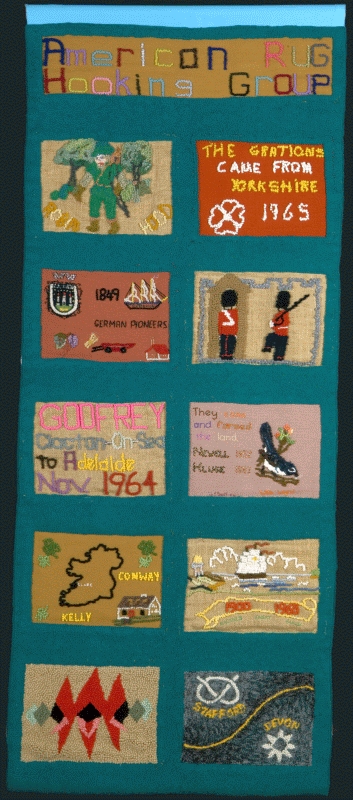
The Internet has made it possible to more easily research the history of rug making in Australia and to reach out to connect with and encourage solitary rug hookers; for interested people to locate instructors; to find repairers and have rugs repaired, completed, or made on commission.
Members of the Guild have attended Craft Fairs in different States around Australia creating publicity for the craft, community groups have been formed and workshops given.
 Martha Birch’s presence at Expertise Events Sydney Craft Fair lead to the formation of the Sydney group “From Rags to Rugs, Sydney Rug Hookers” which meets at the Epping Creative Centre, 26 Stanley St, Dence Park, NSW.
Martha Birch’s presence at Expertise Events Sydney Craft Fair lead to the formation of the Sydney group “From Rags to Rugs, Sydney Rug Hookers” which meets at the Epping Creative Centre, 26 Stanley St, Dence Park, NSW.
For more information contact Martha through the groups Facebook page https://www.facebook.com/groups/387146415123046/members/
The Wanneroo Rugmakers group in Western Australia have been meeting in the  city Library every Saturday morning for 10 years and are often visited by Library patrons who ask to see what they’re doing. Some have a go and join in, others go away and tell friends about the group. Any of the groups core members can teach newcomers and have taught several school teachers the various rug making techniques which the teachers have taken back and taught at their schools. Children’s rug making classes have been given during school holidays and also workshops for Seniors. As well as their own rugs, the group works on a community project each year. Rug Hooking categories have been added to the craft section of the Wanneroo Agricultural Show. Rugs are also shown at the Strathalbyn, SA Show and the Milton Show in NSW.
city Library every Saturday morning for 10 years and are often visited by Library patrons who ask to see what they’re doing. Some have a go and join in, others go away and tell friends about the group. Any of the groups core members can teach newcomers and have taught several school teachers the various rug making techniques which the teachers have taken back and taught at their schools. Children’s rug making classes have been given during school holidays and also workshops for Seniors. As well as their own rugs, the group works on a community project each year. Rug Hooking categories have been added to the craft section of the Wanneroo Agricultural Show. Rugs are also shown at the Strathalbyn, SA Show and the Milton Show in NSW.
In Queensland Judi Tompkins and Judy Brook leaders of two rug hooking groups have been promoting rug making in their own areas and came together mid-year to bring rug hooking to a Winter Craft Festival. For Judi Tompkins it was an expensive learning experience – driving 2 hours each way to set up and take down a solo exhibition and  repeating the drive several times to give
repeating the drive several times to give  artists talks in a remote area ravaged by drought with no through traffic reinforced her thinking that an online exhibition was a better option for promoting hooked pieces as art. However, Judy Brook’s community piece set up for viewers to work on during the month of the craft fair was well received.
artists talks in a remote area ravaged by drought with no through traffic reinforced her thinking that an online exhibition was a better option for promoting hooked pieces as art. However, Judy Brook’s community piece set up for viewers to work on during the month of the craft fair was well received.
In New South Wales the Narrawilly Proggy Rugmakers continue to meet in Miriam Millers Rug Room even when Miriam is away. The local rug hookers love meeting in Miriam’s studio and Miriam stays in touch with visitors to Narrawilly and rug hookers she meets in her overseas travels via her monthly emailed newsletter, “Connecting Us”
Miriam Millers Rug Room even when Miriam is away. The local rug hookers love meeting in Miriam’s studio and Miriam stays in touch with visitors to Narrawilly and rug hookers she meets in her overseas travels via her monthly emailed newsletter, “Connecting Us”
Jacqui Thomson has been documenting the groups many works since 1994 when she placed an few lines in the local newspaper advertising the groups first meeting. Miriam and Jacqui have graduated from local print advertising to the online world.
Following the success of “Re-imagined” a virtual mixed media exhibition in 2018 a group of 3 Aussie Guild members (Judi Tompkins, Kira Mead & Jo Franco) created the Global Textile Hub and held an online rug hooking event, the Global Rug Hub, bringing rug hookers together from around the world; Canada, USA, UK and Europe and of course Australia. This video and webinar can be seen along with other Guild videos on Kira Mead’s YouTube Channel.
online rug hooking event, the Global Rug Hub, bringing rug hookers together from around the world; Canada, USA, UK and Europe and of course Australia. This video and webinar can be seen along with other Guild videos on Kira Mead’s YouTube Channel.
Now the Guild committee comes together from Queensland, New South Wales, ACT and Western Australia to hold monthly virtual meetings.
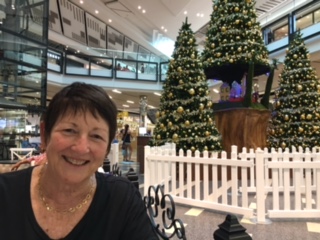 Editors Note: Not only do Australian rugmakers have the chance to connect with each other through various online platforms, they also have a chance to meet up with rugmakers visiting from overseas.
Editors Note: Not only do Australian rugmakers have the chance to connect with each other through various online platforms, they also have a chance to meet up with rugmakers visiting from overseas.
This year through this Blog, several Canadians have visited rug groups in Strathalbyn, SA; Sydney and Milton, NSW and Melbourne, VIC. Currently a visitor from the UK is in South Australia, headed West in the New Year.
Even though few in numbers, rug hookers in Australia are creative in their approach to bringing a traditional craft into the 21st Century with the use of technology.
Wishing you all a Merry Christmas and a Happy and Healthy New Year.
Jo Franco, Editor/Membership Chair









 the inaugural International Rughooking Day. During 2015 at Tamborine Mountain State School in Queensland, Bec took a class of 11 year olds through the process of learning how to design their own patterns and to use a punchneedle to hook them.
the inaugural International Rughooking Day. During 2015 at Tamborine Mountain State School in Queensland, Bec took a class of 11 year olds through the process of learning how to design their own patterns and to use a punchneedle to hook them.

 when Year 7 students became the first year of high-school and Year 6 (11 year olds) became the leaders of the
when Year 7 students became the first year of high-school and Year 6 (11 year olds) became the leaders of the  primary school.
primary school. 
![1 800px-Castle_Howard_-_Temple_of_the_Four_Winds[1]](http://www.rughookingaustralia.com.au/wp-content/uploads/2016/06/1-800px-Castle_Howard_-_Temple_of_the_Four_Winds1-150x150.jpg)
![1 cb418c88b3138e5e8285b9afda332aa8[1]](http://www.rughookingaustralia.com.au/wp-content/uploads/2016/06/1-cb418c88b3138e5e8285b9afda332aa81-150x150.jpg)
![1 images[3]](http://www.rughookingaustralia.com.au/wp-content/uploads/2016/06/1-images3-150x150.jpg)
![1 Sculpture_à_Parc_de_la_Villette,_Paris,_France_juillet_2010[1]](http://www.rughookingaustralia.com.au/wp-content/uploads/2016/06/1-Sculpture_à_Parc_de_la_Villette_Paris_France_juillet_20101-150x150.jpg)
![4 IMG_4318[1]](http://www.rughookingaustralia.com.au/wp-content/uploads/2016/06/4-IMG_43181-225x300.jpg) Having made several wall-hangings using the 3D Waldoborough technique (in the extreme)
Having made several wall-hangings using the 3D Waldoborough technique (in the extreme)
![6 IMG_5132[1]](http://www.rughookingaustralia.com.au/wp-content/uploads/2016/06/6-IMG_51321-1024x768.jpg)


![8 IMG_5150[1]](http://www.rughookingaustralia.com.au/wp-content/uploads/2016/06/8-IMG_51501-1024x768.jpg)
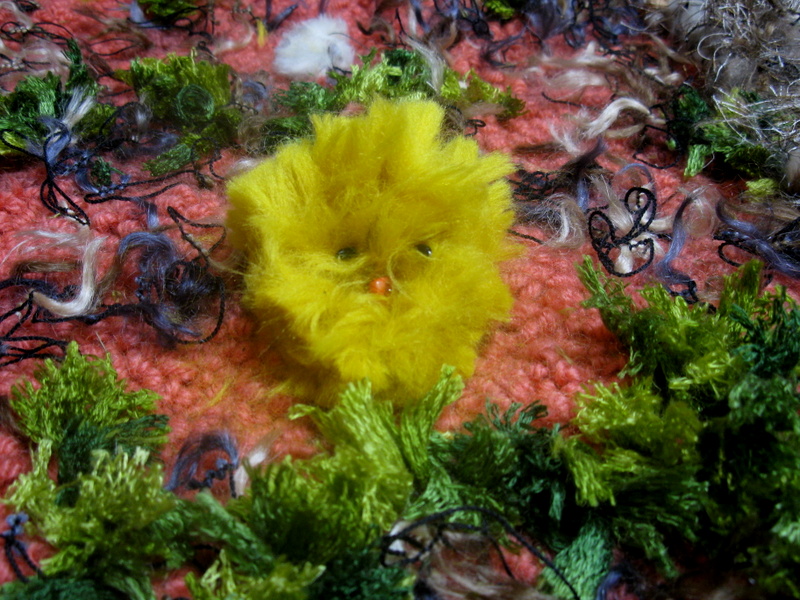
![11 IMG_5181-001[1]](http://www.rughookingaustralia.com.au/wp-content/uploads/2016/06/11-IMG_5181-0011-192x300.jpg)

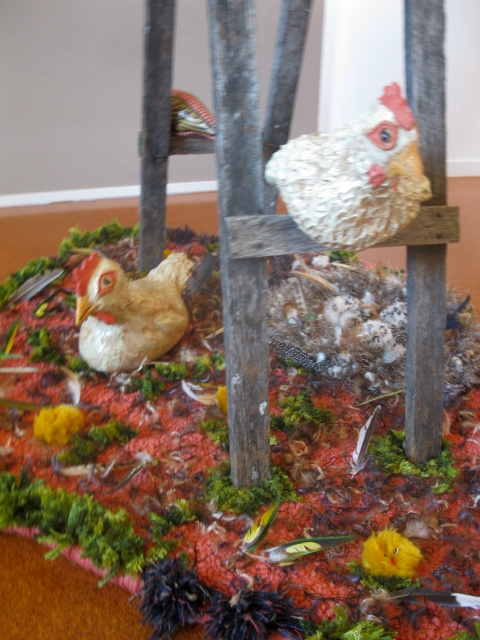





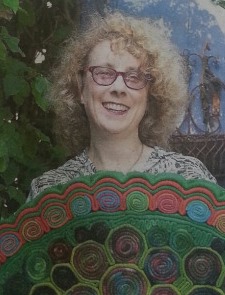
 and various rug making techniques. Her open and sharing personality reflects the bright colours she likes to work with.
and various rug making techniques. Her open and sharing personality reflects the bright colours she likes to work with.